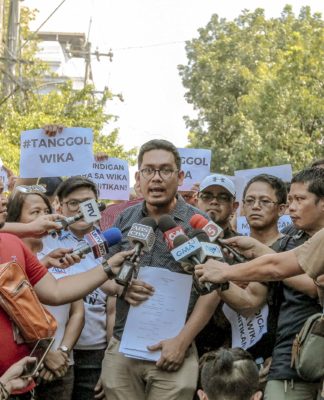 THE FACT that the Central Student Council (CSC) has conducted several meetings with the Office for Student Affairs to revise the Students’ Code, which President Ina Vergara expects to be ratified in August, means the charter is on top of the student government’s priorities.
THE FACT that the Central Student Council (CSC) has conducted several meetings with the Office for Student Affairs to revise the Students’ Code, which President Ina Vergara expects to be ratified in August, means the charter is on top of the student government’s priorities.
Considering the tedious process of reviewing and revising, sudden changes in administration (the code sat through three rectors), and at times, tasks that need immediate attention, like the Quadricentennial celebration in 2011, it is not surprising that passing the charter would take time.
Protecting and promoting the rights of the 45,000-strong UST student body is not an easy task, else it would not have taken 10 years for the code to be ratified.
It remains unfinished to this day.
Only a few of us know that a code which will guarantee and legally protect all our rights as students—including freedom of expression, right to information, and right to due process, among others—is in progress.
Former CSC vice-president Raymond Angelo Gonzales previously even blamed student apathy for the postponement of this code time and again.
This indifference could result in two things, in case it continues:
First, when local student councils call for a college-wide consultation for the Students’ Code (since the CSC decided not to hold a plebiscite), majority of students might not attend, dismissing it as boring.
Worse, student apathy might result in a failure of election so that the code might not be ratified at all.
Thus, it is a good thing that the CSC is eager on bringing the charter closer to passage, so that we students, apathetic and concerned alike, could finally benefit from the Students’ Code.
However, would there be apathy in the first place if Thomasians feel a pressing need for a charter?
Most, if not all, students enter and graduate from UST without looking for a missing piece that is supposedly the Students’ Code.
On the bright side, that would mean students do not feel oppressed or deprived of the inalienable rights due them in any way during their stay in the University, despite not having a magna carta—but that would also mean lack of a safety net should the need arise in the future.
Or is there a lack of awareness due to the absence of a more efficient method of information dissemination about the Students’ Code?
If that were the case, then perhaps it is up to the CSC to show the necessity of the Students’ Code through better means of educating the Thomasian community, especially by citing instances of some sort of oppression that would make the Students’ Code paramount. An example that would raise such awareness would be the Students’ Rights Awareness Week, which the CSC plans to conduct in October.
If every student is at least knowledgeable of the pending charter, then it would be easier to cut off the shelf life of the Students’ Code into 10 years maximum.
Besides, the University of the Philippines, Ateneo de Manila, and De La Salle University all have their own magna carta of the rights of students. It is about time UST has its own.
CSC first drafted the Students’ Code in 2004, when it was initially named the Magna Carta of Students’ Rights. It was almost signed in 2006 by then Rector Fr. Ernesto Arceo, O.P., but was put on hold following his resignation due to a dispute on the P3-billion UST Hospital expansion.
CSC officers went back to “zero” when Fr. Rolando De la Rosa, O.P. assumed office. But when De la Rosa resigned in 2011, he opted his successor to take on responsibility.
The latest draft of the Students’ Code has yet to reach Rector Fr. Herminio Dagohoy, O.P.
















